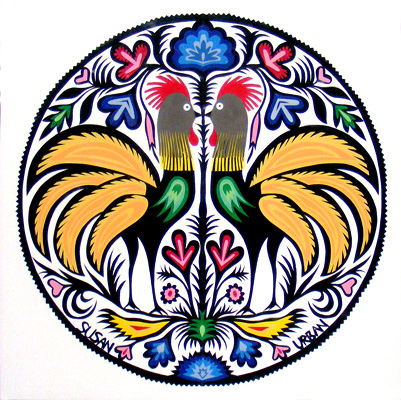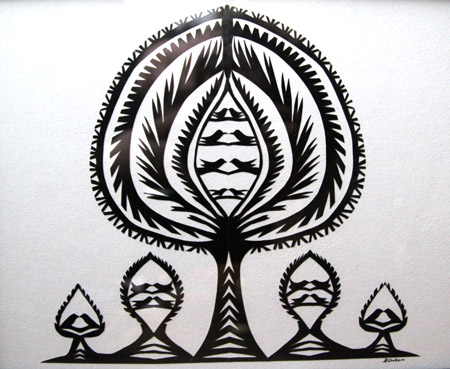Susan Urban practices the Polish art of wycinanki (paper cut design). She also makes cut paper dolls wearing costumes from different regions of Poland. Generations of West Springfield school children have benefited from having her as their art teacher.
Wycinanki are believed to have originated with Polish peasants. Farm women hung sheep skins over the window openings of their farmhouses as a way of keeping out the elements. In order to let in light and air, they used sheep shears to snip small openings in the skins. Like many folk arts, the practice was both functional and decorative. At some point, Polish women transferred their designs to paper.
In Poland, wycinanki vary by region. The women of Kurpie are famous for their paper cut-outs of animals, geometric designs, and flowers. These symmetrical designs are cut from a single piece of colored paper, folded once. Another style comes from the area of Lowicz and is distinguished by many layers of multi-colored paper. The native Polish rooster, which is black and noted for its strange-shaped tail feathers, is a popular subject for paper cutting. Some designs with repeated elements are made by folding the paper and cutting through as many as eight layers at a time.
Susan Urban will be demonstrating the art of Polish papercut design in the folk craft area of the Lowell Folk Festival.



Ms Urban, My interest in Polish cut-outs dates back many years, inspired by Les Decoupures de Papier, Dr Eugenjusz Frankowski, J. Mortkowicz, Warsaw & Cracow,nineteen twenty-eight. The author inscribed my copy to my mother.
My particular (non-professional) interest is in the cut-outs of Lowicz but that interest embraces those of Kurpie and of ‘toute la Petite-Pologne’.
I should be grateful for whatever thoughts you may wish to offer on the inspiration behind and practice of this art.
In hope this reaches you,
Charles Harley